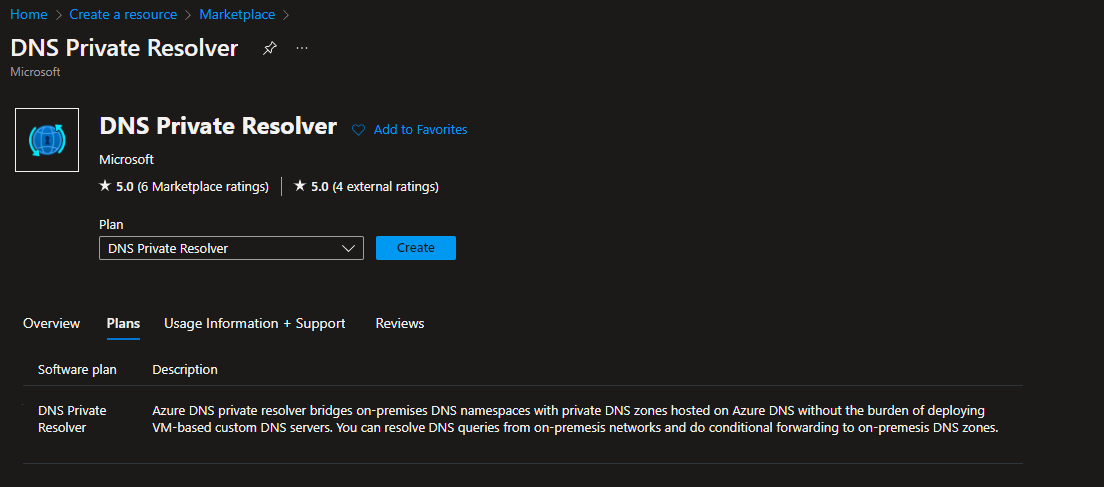Hi @Jackson Martins ,
I've created the DNS Private Resolver succesfully.
However no change in DNS Name Resolution via Azure VPN Client.
$targetDNS1 = IP of Inbound Endpoint
I've also tested by putting the private endpoint IP's in a hostfile, ping doesn't work, but does use the private IP (as expected).
When I attempt to connect to <name>.privatelink.database.net via SQLSMS, the following error is returned:
"A connection was succesfully established with the server, but then an error occured during the login process. Targert Princple Name is incorrect."
Fixed that by selecting "Thrust Server Certificate" and subsequently the connection was made succesfully.
For <name>.privatelink.file.core.windows.net it also works when I use the hostfile.
When I remove the hostfile entry for both, it still doesn't work.
Any thoughts to what I might be overlooking?
Script I used is below:
Install-Module Az.DnsResolver
Get-InstalledModule -Name Az.DnsResolver
New-AzDnsResolver -Name CLIENT-dns-private-resolver -ResourceGroupName RESOURCEGROUP -Location westeurope -VirtualNetworkId "/subscriptions/SUBSCRIPTIONID/resourceGroups/RESOURCEGROUP/providers/Microsoft.Network/virtualNetworks/CLIENT.virtualnetwork"
$dnsResolver = Get-AzDnsResolver -Name CLIENT-dns-private-resolver -ResourceGroupName RESOURCEGROUP
$dnsResolver.ToJsonString()
$ipconfig = New-AzDnsResolverIPConfigurationObject -PrivateIPAllocationMethod Dynamic -SubnetId /subscriptions/SUBSCRIPTIONID/resourceGroups/RESOURCEGROUP/providers/Microsoft.Network/virtualNetworks/CLIENT.virtualnetwork/subnets/CLIENT.inbound.subnet
New-AzDnsResolverInboundEndpoint -DnsResolverName CLIENT-dns-private-resolver -Name DNS-Priv-Resolver-Inbound-Endpoint -ResourceGroupName RESOURCEGROUP -Location westeurope -IpConfiguration $ipconfig
$inboundEndpoint = Get-AzDnsResolverInboundEndpoint -Name DNS-Priv-Resolver-Inbound-Endpoint -DnsResolverName CLIENT-dns-private-resolver -ResourceGroupName RESOURCEGROUP
$inboundEndpoint.ToJsonString()
New-AzDnsResolverOutboundEndpoint -DnsResolverName CLIENT-dns-private-resolver -Name DNS-Priv-Resolver-Outbound-Endpoint -ResourceGroupName RESOURCEGROUP -Location westeurope -SubnetId /subscriptions/SUBSCRIPTIONID/resourceGroups/RESOURCEGROUP/providers/Microsoft.Network/virtualNetworks/CLIENT.virtualnetwork/subnets/CLIENT.outbound.subnet
$outboundEndpoint = Get-AzDnsResolverOutboundEndpoint -Name DNS-Priv-Resolver-Outbound-Endpoint -DnsResolverName CLIENT-dns-private-resolver -ResourceGroupName RESOURCEGROUP
$outboundEndpoint.ToJsonString()
New-AzDnsForwardingRuleset -Name DNSForwardingRuleSet -ResourceGroupName RESOURCEGROUP -DnsResolverOutboundEndpoint $outboundendpoint -Location westeurope
$dnsForwardingRuleset = Get-AzDnsForwardingRuleset -Name DNSForwardingRuleSet -ResourceGroupName RESOURCEGROUP
$dnsForwardingRuleset.ToJsonString()
$vnet = Get-AzVirtualNetwork -Name CLIENT.virtualnetwork -ResourceGroupName RESOURCEGROUP
$vnetlink = New-AzDnsForwardingRulesetVirtualNetworkLink -DnsForwardingRulesetName $dnsForwardingRuleset.Name -ResourceGroupName RESOURCEGROUP -VirtualNetworkLinkName "vnetlink" -VirtualNetworkId $vnet.Id -SubscriptionId SUBSCRIPTIONID
$virtualNetworkLink = Get-AzDnsForwardingRulesetVirtualNetworkLink -DnsForwardingRulesetName $dnsForwardingRuleset.Name -ResourceGroupName RESOURCEGROUP
$virtualNetworkLink.ToJsonString()
$vnet2 = New-AzVirtualNetwork -Name CLIENT.dns.virtualnetwork -ResourceGroupName RESOURCEGROUP -Location westeurope -AddressPrefix "10.1.1.0/24"
$vnetlink2 = New-AzDnsForwardingRulesetVirtualNetworkLink -DnsForwardingRulesetName $dnsForwardingRuleset.Name -ResourceGroupName RESOURCEGROUP -VirtualNetworkLinkName "vnetlink2" -VirtualNetworkId $vnet2.Id -SubscriptionId SUBSCRIPTIONID
$virtualNetworkLink2 = Get-AzDnsForwardingRulesetVirtualNetworkLink -DnsForwardingRulesetName $dnsForwardingRuleset.Name -ResourceGroupName RESOURCEGROUP
$virtualNetworkLink2.ToJsonString()
$targetDNS1 = New-AzDnsResolverTargetDnsServerObject -IPAddress 192.168.210.4 -Port 53
$forwardingrule = New-AzDnsForwardingRulesetForwardingRule -ResourceGroupName RESOURCEGROUP -DnsForwardingRulesetName DNSForwardingRuleSet -Name "AzurePrivate" -DomainName "." -ForwardingRuleState "Enabled" -TargetDnsServer $targetDNS1



